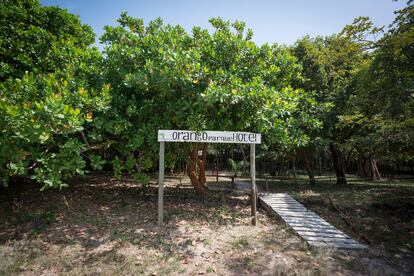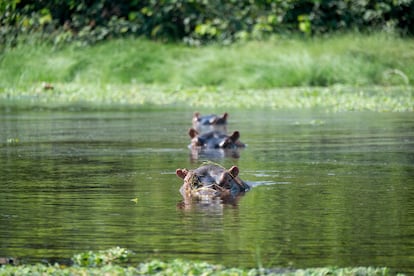Orango National Park: mangroves, pristine beaches and villages in the most fascinating place in Guinea-Bissau

In Guinea-Bissau there is a paradise waiting to be explored: the Bijagós Islands . This impressive archipelago, some 48 kilometres from Africa, has some 88 islands, and many of them are uninhabited. Mass tourism has not yet reached this point, although it may do so in a while, because as one of the most renowned travel journalists in Spain, Paco Nadal, points out, Africa will certainly be one of the continents with the greatest tourist potential in the coming years.
In the Bijagós Islands, animist culture is still very present, which is why they are considered sacred and untouchable; for this reason, human presence is not accepted except in cases where they are used for rice cultivation, the main livelihood of Guinea.
Its more than 12,000 hectares were considered a biosphere reserve by UNESCO in 1996, and foundations such as BirdLife consider it a place of important value for the observation and conservation of birds in the world, including aquatic birds. Its more than 30,000 inhabitants live in harmony with nature, so much so that one could not exist without the other.

Formosa Island is the largest , Bubaque the most populated and Bolama the administrative capital, but we stop in Orango, where the national park is located, a protected area since 2000 with an area of more than 1,500 square kilometres, of which 160 square kilometres are covered by mangroves and lagoons; a true oasis that is home to species of mammals, reptiles and birds of international importance, including the Caspian tern (Sterna caspia), the grey-headed gull (Larus cirrhocephalus), the Senegal parrot (Poicephalus senegalus) and the endangered grey parrot (Psittacus erithacus timneh). The park is also home to populations of hippos, which, unlike their freshwater relatives elsewhere, love the ocean. The park is also home to monkey species, African manatees and several species of reptiles, including sea turtles, which, like parrots, are in danger of extinction. Of the seven species of sea turtles in the world, five of them frequent the park's beaches.
Located at the southwestern tip of the Bijagós Archipelago, Orango National Park is one of the core areas of the biosphere reserve in recognition of the intimate relationship between the population and the surrounding biodiversity that has evolved over the centuries. The Orango complex is made up of five islands (Orango Grande, Orangozinho, Menegue, Canogo and Imbone) and three islets (Adonga, Canuopa and Tanhiba). It currently includes 33 villages, with an estimated population of about 3,369 inhabitants, mainly of the Bijagó ethnic group, whose main curiosity is that it is a matriarchal society.
This community also has a conception of the natural world as being endowed with movement, soul and its own consciousness. So we could say that the Bijagós are true guardians of the biosphere.

As explained by the Orango Parque Hotel , this is not just a tourist establishment, but also functions as a centre for the development of ecotourism in the national parks of Guinea-Bissau and, in particular, in the Bijagós Islands and the Orango and Vieira Poilão national parks.
The hotel is also the base for many collaborative projects developed together with IBAP (Instituto da Biodiversidade e das Áreas Protegidas) within the park: conservation projects targeting the region’s manatee and hippo populations, projects designed to reduce conflicts between local people and wildlife, and projects for building wells or renovating community health centres, among others. The two main goals of the current projects are to maintain the hotel’s increasing occupancy rates in order to achieve financial independence and to increase the capacity of local staff to manage the hotel and ecotourism activities with complete autonomy.
Behind Orango Parque Hotel is the Foundation for the Conservation of Biodiversity and its Habitat ( CBD-Habitat ), founded in 1998, whose objective is the preservation of biodiversity, with vital projects such as the recovery of the Iberian lynx, the Mediterranean monk seal, the Iberian imperial eagle or the black vulture.

With its 14 rooms, this is the only hotel within the Bolama-Bijagós Biosphere Reserve, so it is a safe bet for those who want to delve deeper into this remote part of Africa. It can accommodate only about 28 people, which allows its guests to fully immerse themselves in the idiosyncrasy of this community.
This hotel has a restaurant, as well as access to the excellent beaches with crystal-clear waters of the Bijagós Islands. Grilled fish, mangrove oysters or palm wine are just some of the delicacies you can try on their menu, which is served daily. Needless to say, all of them come from their local market and are fresh. “As Orango is four hours by boat from Bissau, the capital, if the fresh products we need have run out, there is no other solution than to buy them in Bissau when we go to pick up the travelers, and bring them back on our own boats. Despite these relative supply difficulties, food is one of the most valued aspects by visitors to Orango Parque Hotel,” they explain on their own blog.
Also noteworthy is their vegetarian offering, which they introduced two years ago, following the arrival of British and Germans who were demanding a greener type of diet. From their organic garden they provide varied and very colourful dishes that they fuse with basics of their cuisine such as rice, beans, carrots and tomatoes. The traditions of the Bijagó people are behind this cuisine, since, as they say, they preserve a sustainable culture that is perfectly in harmony with what the land gives them.

Orango is known for its hippos, the kings of this sacred place. However, it is not always possible to see them. One of the most renowned natural sound specialists in Spain, Carlos de Hita , has come here to capture the sound essence of this African paradise. He was also the protagonist of Carlos Pérez's documentary called The Island of the Hippos. “Behind the wall of tusks and muscles that form the herds of females, accompanied by some males tolerated by the leader, there are stories of nobility and power, and an immovable hierarchy,” said the director from Extremadura at the presentation of the documentary in 2019.
These saltwater animals, revered by the Bijagó ethnic group, live among mangroves, rivers and lagoons, with the Anor region being the favourite for spending the dry season. Seeing them in action is quite an experience: they can grow to four metres and weigh 3,500 kilos. Their gestation period can last around eight months and, from birth, they have a voracious appetite, but they are vegetarian.
Do you want to discover this paradise in Africa with the help of a guide? EL PAÍS VIAJES has it all ready for you: on October 11, 2025 (and until October 18) you will travel to Guinea-Bissau with Ana Maroto, biologist and diver, member of the CBD-Hábitat Foundation, collaborator of EL PAÍS VIAJES and one of the founders of the Orango Parque Hotel, in other words, a luxury hostess to discover one of the most unknown corners of the continent. Sign up at this link.
*If you want more information about this and other similar trips, visit our EL PAÍS VIAJES website .
You can follow EL PAÍS VIAJES on Facebook and Instagram , or subscribe to the EL PAÍS Viajes newsletter here .
EL PAÍS






